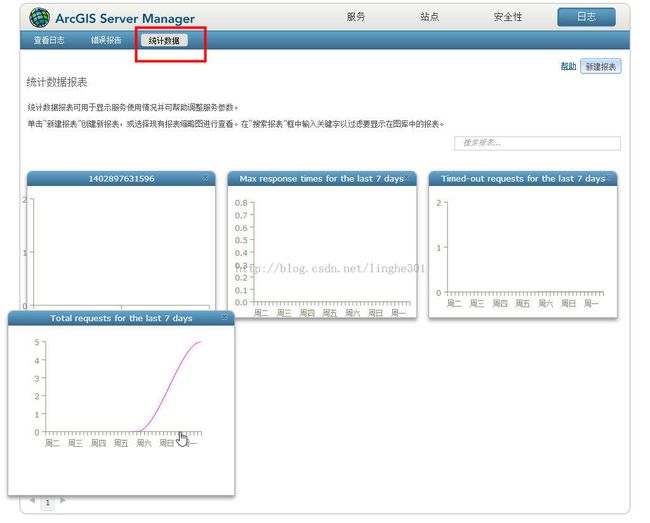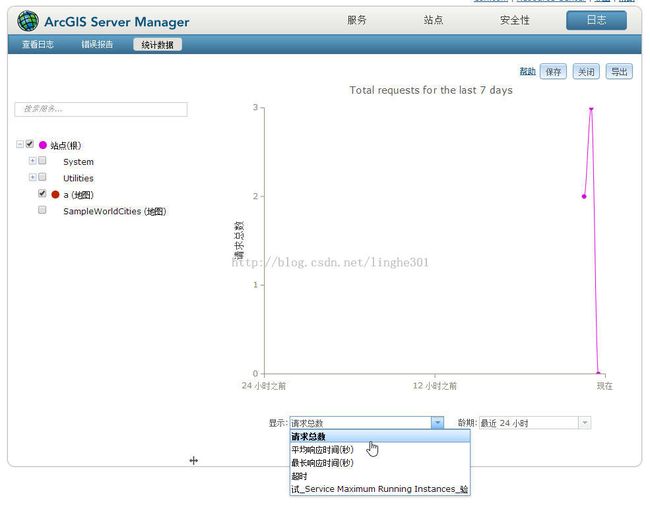ArcGIS 10.3 for Server新特性介绍
ArcGIS10.3的正式版马上在美国Esri全球用户大会推出,中国的正式发行时间估计在Esri中国的用户大会,下面就将用户比较关心的ArcGIS 10.3 for Server的新特性给大家进行简单说明!
----------------------------------------------------------------------------------
版权所有,文章允许转载,但必须以链接方式注明源地址,否则追究法律责任!
建议看到转载,请直接访问正版链接获得最新的ArcGIS技术文章
Blog: http://blog.csdn.net/linghe301
----------------------------------------------------------------------------------
Monitor server statistics using ArcGIS Server Manager
ArcGIS Server records various service statistics, such as total requests, average response time, and timeouts, and reports this information in ArcGIS Server Manager as one or a series of graphs. Administrators and publishers can use this information to monitor service activity and better understand how clients are using services.
ArcGIS Server记录了种类繁多的服务统计信息,比如总请求数,平均响应时间,超时等,ArcGIS Server管理器会将这些信息以图形曲线的方式报告给用户,ArcGIS Server管理员和服务发布人员可以根据这些信息来监控服务活动,更好的了解客户端是怎么使用这些服务的。
ArcGIS GeoEvent Processor stream services
The ArcGIS GeoEvent Processor for Server extension exposes a new type of service, called the stream service, which emphasizes low latency, real-time data dissemination, for client/server data flows. Clients connecting to a stream service begin receiving data immediately upon subscribing to the service. Clients can specify and reconfigure both spatial and attribute constraints without first unsubscribing and then reconnecting to the service.
在ArcGIS GeoEvent处理器的服务器扩展暴露了一个新的服务类型,称为流服务,它针对客户端/服务器的数据流,强调低延迟,实时数据发布。客户端连接到一个流服务后,立即为订阅的服务接收数据。客户端可以在不退订服务的情况下,指定并重新配置空间和属性限制,然后重新连接到该服务。
What is a Stream Service?
A Stream Service is a new type of ArcGIS Server service which emphasizes low latency, real-time data dissemination, for client/server data flows. Clients connecting to a Stream Service begin receiving data immediately upon subscribing to the service. Clients can specify and reconfigure both spatial and attribute constraints without first unsubscribing and then reconnecting to the service.
The ArcGIS GeoEvent Processor for Server extension must be incorporated into your GIS Enterprise in order to leverage Stream Services. Initially, only clients developed using the ArcGIS API for JavaScript will be able to connect to a Stream Service. Future releases will support a wider variety of client subscriptions.
See What is GeoEvent Processor for more information on ArcGIS GeoEvent Processor for Server.
Stream Services leverage WebSocket technology which supports full-duplex, bi-directional communication. This enables clients to specify the data they want to receive without having to unsubscribe and reestablish their connection to the service. Clients are able to filter Stream Service data by specifying either spatial or attribute constraints.
Connecting to a Stream Service to receive a real-time data feed allows you to separate the basic need of immediate event visualization from the need to persist data in a database. By configuring a GeoEvent Processor output to broadcast event data via a Stream Service you will have the option of archiving or persisting event data in an enterprise data store, but doing so is not a requirement for data visualization.
The illustration below compares how feature data has traditionally been received, processed, and consumed with how real-time data is received and broadcast using Stream Services.
----------------------------------------------------------------------------------
版权所有,文章允许转载,但必须以链接方式注明源地址,否则追究法律责任!
建议看到转载,请直接访问正版链接获得最新的ArcGIS技术文章
Blog: http://blog.csdn.net/linghe301
----------------------------------------------------------------------------------
OGC WFS 2.0 support
The Open Geospatial Consortium (OGC) Web Feature Services (WFS) you create and host on ArcGIS Server now support the WFS 2.0 specification. The ArcGIS Server implementation of the WFS 2.0 specification addresses the required features of the simple WFS profile, transactions, response paging, and stored queries.
ArcGIS10.3 for Server上现在支持WFS2.0规范。在WFS2.0规范的ArcGIS Server实现解决了简单的WFS配置文件,交互,寻呼响应,和存储查询所需的功能。
----------------------------------------------------------------------------------
版权所有,文章允许转载,但必须以链接方式注明源地址,否则追究法律责任!
建议看到转载,请直接访问正版链接获得最新的ArcGIS技术文章
Blog: http://blog.csdn.net/linghe301
----------------------------------------------------------------------------------
Altibase™内存数据库管理系统(DBMS),内存数据管理系统的最新技术,是一个在事务优先的环境中提供高性能和高可用性的软件解决方案。Altibase提供极限性能、容错能力和事务管理的方便性,特别是在通信、网上银行、证券交易、实时应用和嵌入式系统领域。Altibase能够最大限度的发挥数据库服务系统的潜力,使用Altibase能大大增强您公司的数据服务器的处理能力。
----------------------------------------------------------------------------------
版权所有,文章允许转载,但必须以链接方式注明源地址,否则追究法律责任!
建议看到转载,请直接访问正版链接获得最新的ArcGIS技术文章
Blog: http://blog.csdn.net/linghe301
----------------------------------------------------------------------------------
既然有了ArcGIS10.3新版本的推出,那么版本间的兼容性问题肯定是大家所关注的,下面来看一下关于这个问题的解答。以下我就不再进行翻译了!
Can I view and use my 10.3 services within an earlier version of ArcGIS for Desktop?
Yes. You can add 10.3 services to earlier versions of ArcGIS for Desktop and use them in the same way that you used them in the past, including as a layer in ArcMap. This is accomplished purely through web service communication and not the local (DCOM) connections that are an option in 10.0. The fundamental structure and format of REST and SOAP requests a client makes to an ArcGIS Server web service have not changed at version10.3.
If your 10.3 ArcGIS Server site is federated with Portal for ArcGIS and you are connecting from a pre-10.2 version of ArcGIS for Desktop, you must access your services through ArcMap using Add Data > Add Data from Portal for ArcGIS. You cannot connect to the server by clicking Add ArcGIS Server.
Can I publish a service to 10.3 using an earlier version of ArcGIS for Desktop?
Generally, you can use a 10.1 or later version of ArcGIS for Desktop to publish a service to a 10.3 server. However, there are some restrictions to publishing with 10.1 if you are attempting to take advantage of functionality exclusive to 10.3:
- If you're using web-tier authentication for your administrative connection, you must use 10.2 or later to publish.
- If you are publishing to a server that is federated with Portal for ArcGIS, you must use 10.2 or later to publish.
Can I publish a service to a 10.1 or 10.1 SP1 server using ArcGIS 10.3 for Desktop?
Yes. You can publish services to a 10.1 or 10.1 SP1 version of ArcGIS Server using a 10.3 version of ArcGIS for Desktop. However, you will not be able to take advantage of any new 10.3 functionality until your server is upgraded to 10.3.
Can I administer a 10.3 server using an earlier version of ArcGIS for Desktop?
No. You must use version 10.3 to administer a 10.3 server. In the scenario where you have upgraded to ArcGIS 10.3for Server but you have not upgraded Desktop, consider using the ArcGIS Server Manager web application to administer your server.
Can I administer a 10.0 server using a later version of ArcGIS for Desktop?
No. You must use version 10.0 to administer a 10.0 server. In the scenario where you have upgraded to ArcGIS 10.3for Desktop and you need to administer a server from an earlier version, consider using the ArcGIS Server Manager web application to administer the server.
Can I configure an earlier version of the ArcGIS Web Adaptor with my 10.3 server?
No. To configure the Web Adaptor with ArcGIS Server, both products need to be running version 10.3.
Can I install the ArcGIS 10.3 Web Adaptor (IIS) on the same machine as a previous version of the ArcGIS Web Adaptor (IIS)?
Yes. Beginning at 10.2.1, you can have a 10.2.1 version of the ArcGIS Web Adaptor (IIS) installed alongside one other previous version of the Web Adaptor on the same machine. For example, you can have a 10.1 SP1 version and a 10.3 version of the Web Adaptor installed on the same web server.
As with previous releases, the Web Adaptor's version must always match the version of ArcGIS Server. For example, you cannot configure a 10.3 version of the Web Adaptor with ArcGIS 10.2 for Server.
If you want to upgrade a previous version of the ArcGIS Web Adaptor (IIS) to 10.3, you'll need to uninstall the old version and install the 10.3 setup. After installing 10.3, you'll need to configure the Web Adaptor with ArcGIS Server.
----------------------------------------------------------------------------------
版权所有,文章允许转载,但必须以链接方式注明源地址,否则追究法律责任!
建议看到转载,请直接访问正版链接获得最新的ArcGIS技术文章
Blog: http://blog.csdn.net/linghe301
----------------------------------------------------------------------------------
In 10.3, can I reuse a map cache I created in an earlier version so I don't have to re-create the cache?
Yes. Map caches from 10.1 are available immediately. With 10.0 caches, make sure your cache is sitting in a server cache directory registered with ArcGIS 10.3 for Server (either by moving your cache or by registering its current location as a server cache directory). Then republish the service at 10.3 with the same name it used in 10.0 and configure the service to point to the appropriate cache directory.
Using 10.3, can I connect to earlier versions of the geodatabase?
Yes. See Client and geodatabase compatibility for a list of compatible versions.
Can I publish services to ArcGIS 10.3 for Server that contain data from a previous geodatabase version?
In most cases, the geodatabase version does not have to match the version of ArcGIS Server. For specific information on which geodatabase versions are supported with ArcGIS 10.3 for Server, see Client and geodatabase compatibility.
Do I need to upgrade my geodatabase in order to use it as ArcGIS 10.3 for Server's Managed Database?
A geodatabase version of 9.3 or later can be used as ArcGIS 10.3 for Server's Managed Database. To learn more about ArcGIS Server's Managed Database, see Copying data to the server automatically when publishing.
----------------------------------------------------------------------------------
版权所有,文章允许转载,但必须以链接方式注明源地址,否则追究法律责任!
建议看到转载,请直接访问正版链接获得最新的ArcGIS技术文章
Blog: http://blog.csdn.net/linghe301
----------------------------------------------------------------------------------

